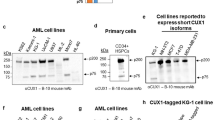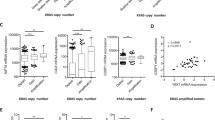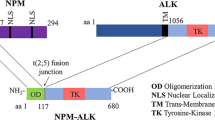Abstract
The HDM2 oncoprotein is a cellular inhibitor of p53 and is frequently deregulated in human cancer. However, the HDM2 gene encodes alternatively spliced variants whose functional significance is poorly understood. We had previously reported the detection of alternative HDM2 forms in Hodgkin's lymphoma (HL)-derived cell lines. Here, we have cloned several of these transcripts, including the previously described HDM2-A, -B and -C (which encode the COOH terminus of HDM2), and two novel variants (HDM2-HL1 and -HL2) containing a complete p53 interaction domain. Real-time PCR assays demonstrated that HDM2-A and -B were selectively expressed by HL cell lines and primary tumors, compared with their non-neoplastic counterparts. In transient transfection experiments, alternatively spliced HDM2 isoforms were partially or totally localized within the cytoplasm. HDM2-HL2 was able to inhibit transactivation of a p53-inducible reporter construct and induced a partial relocalization of p53 to the cytoplasm. Expression of HDM2-A and -B caused the activation of p53/p21 and induced growth arrest in primary cells, but also increased the expression levels of cyclins D1 and E. Other possible genes regulated by HDM2-A and -B were identified using cDNA microarray technology. These results imply that HDM2 isoforms may have multiple effects on cell cycle control, and provide insight into the mechanisms through which these molecules contribute to tumorigenesis.
This is a preview of subscription content, access via your institution
Access options
Subscribe to this journal
Receive 50 print issues and online access
$259.00 per year
only $5.18 per issue
Buy this article
- Purchase on Springer Link
- Instant access to full article PDF
Prices may be subject to local taxes which are calculated during checkout





Similar content being viewed by others
References
Barak Y, Gottlieb E, Juven-Gershon T, Oren M . (1994). Genes Dev 8: 1739–1749.
Bartel F, Meye A, Wurl P, Kappler M, Bache M, Lautenschlager C et al. (2001). Int J Cancer 95: 168–175.
Bartel F, Taubert H, Harris LC . (2002). Cancer Cell 2: 9–15.
Bartel F, Taylor AC, Taubert H, Harris LC . (2000). Oncol Res 12: 451–457.
Brown DR, Thomas CA, Deb SP . (1998). EMBO J 17: 2513–2525.
Dang J, Kuo ML, Eischen CM, Stepanova L, Sherr CJ, Roussel MF . (2002). Cancer Res 62: 1222–1230.
Di Como CJ, Gaiddon C, Prives C . (1999). Mol Cell Biol 19: 1438–1449.
Evans SC, Viswanathan M, Grier JD, Narayana M, El-Naggar AK, Lozano G . (2001). Oncogene 20: 4041–4049.
Evdokiou A, Atkins GJ, Bouralexis S, Hay S, Raggatt LJ, Cowled PA et al. (2001). Int J Oncol 19: 625–632.
Fridman JS, Hernando E, Hemann MT, De Stanchina E, Cordon-Cardo C, Lowe SW . (2003). Cancer Res 63: 5703–5706.
Garcia JF, Camacho FI, Morente M, Fraga M, Montalban C, Alvaro T et al. (2003). Blood 101: 681–689.
Garcia JF, Villuendas R, Sanchez-Beato M, Sanchez-Aguilera A, Sanchez L, Prieto I et al. (2002). Am J Pathol 160: 569–578.
Haupt Y, Maya R, Kazaz A, Oren M . (1997). Nature 387: 296–299.
Hori M, Shimazaki J, Inagawa S, Itabashi M . (2000). Pathol Int 50: 786–792.
Jones SN, Hancock AR, Vogel H, Donehower LA, Bradley A . (1998). Proc Natl Acad Sci USA 95: 15608–15612.
Kapp U, Yeh WC, Patterson B, Elia AJ, Kagi D, Ho A et al. (1999). J Exp Med 189: 1939–1946.
Kraus A, Neff F, Behn M, Schuermann M, Muenkel K, Schlegel J . (1999). Int J Cancer 80: 930–934.
Kubbutat MH, Jones SN, Vousden KH . (1997). Nature 387: 299–303.
Lukas J, Gao DQ, Keshmeshian M, Wen WH, Tsao-Wei D, Rosenberg S et al. (2001). Cancer Res 61: 3212–3219.
Martin K, Trouche D, Hagemeier C, Sorensen TS, La Thangue NB, Kouzarides T . (1995). Nature 375: 691–694.
Matsumoto R, Tada M, Nozaki M, Zhang CL, Sawamura Y, Abe H . (1998). Cancer Res 58: 609–613.
Maxwell SA . (1994). Anticancer Res 14: 2541–2547.
Momand J, Jung D, Wilczynski S, Niland J . (1998). Nucleic Acids Res 26: 3453–3459.
Momand J, Wu HH, Dasgupta G . (2000). Gene 242: 15–29.
Momand J, Zambetti GP, Olson DC, George D, Levine AJ . (1992). Cell 69: 1237–1245.
Nelsen CJ, Kuriyama R, Hirsch B, Negron VC, Lingle WL, Goggin MM et al. (2004). J Biol Chem 280: 768–776.
Oelmann E, Herbst H, Zuhlsdorf M, Albrecht O, Nolte A, Schmitmann C et al. (2002). Blood 99: 258–267.
Oliner JD, Kinzler KW, Meltzer PS, George DL, Vogelstein B . (1992). Nature 358: 80–83.
Ongkeko WM, Wang XQ, Siu WY, Lau AW, Yamashita K, Harris AL et al. (1999). Curr Biol 9: 829–832.
Pinkas J, Naber SP, Butel JS, Medina D, Jerry DJ . (1999). Int J Cancer 81: 292–298.
Rajagopalan H, Jallepalli PV, Rago C, Velculescu VE, Kinzler KW, Vogelstein B et al. (2004). Nature 428: 77–81.
Sanchez-Aguilera A, Sanchez-Beato M, Garcia JF, Prieto I, Pollan M, Piris MA . (2002). Blood 99: 1411–1418.
Serrano M, Lin AW, McCurrach ME, Beach D, Lowe SW . (1997). Cell 88: 593–602.
Sigalas I, Calvert AH, Anderson JJ, Neal DE, Lunec J . (1996). Nat Med 2: 912–917.
Smith CW, Valcarcel J . (2000). Trends Biochem Sci 25: 381–388.
Soussi T, Beroud C . (2001). Nat Rev Cancer 1: 233–240.
Steinman HA, Burstein E, Lengner C, Gosselin J, Pihan G, Duckett CS et al. (2004). J Biol Chem 279: 4877–4886.
Tamborini E, Della Torre G, Lavarino C, Azzarelli A, Carpinelli P, Pierotti MA et al. (2001). Int J Cancer 92: 790–796.
Tracey L, Villuendas R, Ortiz P, Dopazo A, Spiteri I, Lombardia L et al. (2002). Am J Pathol 161: 1825–1837.
Tzankov A, Zimpfer A, Lugli A, Krugmann J, Went P, Schraml P et al. (2003). J Pathol 199: 201–207.
Watanabe T, Hotta T, Ichikawa A, Kinoshita T, Nagai H, Uchida T et al. (1994). Blood 84: 3158–3165.
Weiss RH . (2003). Cancer Cell 4: 425–429.
Wu X, Bayle JH, Olson D, Levine AJ . (1993). Genes Dev 7: 1126–1132.
Acknowledgements
We thank the Tumour Bank Network coordinated by the Molecular Pathology Programme of the CNIO, for providing the tissue samples; members of the Experimental Oncology, Tumor Suppression, and Assay Development groups of the CNIO for reagents and methodological advice; Paloma de la Cueva and Lourdes Romero for excellent technical assistance; and Manuel Serrano for a critical reading of the manuscript.
This work was supported by grants from the Comunidad Autónoma de Madrid (08.1/0042.1/2003), the Ministerio de Ciencia y Tecnología (SAF2001-0060), and the Fondo de Investigaciones Sanitarias (FIS, G03/179). AS-A is supported by a fellowship from the Consejería de Educación de la Comunidad de Madrid and the European Social Fund.
Author information
Authors and Affiliations
Corresponding author
Rights and permissions
About this article
Cite this article
Sánchez-Aguilera, A., García, J., Sánchez-Beato, M. et al. Hodgkin's lymphoma cells express alternatively spliced forms of HDM2 with multiple effects on cell cycle control. Oncogene 25, 2565–2574 (2006). https://doi.org/10.1038/sj.onc.1209282
Received:
Revised:
Accepted:
Published:
Issue Date:
DOI: https://doi.org/10.1038/sj.onc.1209282
Keywords
This article is cited by
-
A novel mouse model of rhabdomyosarcoma underscores the dichotomy of MDM2-ALT1 function in vivo
Oncogene (2018)
-
Impact of the MDM2 splice-variants MDM2-A, MDM2-B and MDM2-C on cytotoxic stress response in breast cancer cells
BMC Cell Biology (2017)
-
Model-based contextualization of in vitro toxicity data quantitatively predicts in vivo drug response in patients
Archives of Toxicology (2017)
-
Deletion analysis and alternative splicing define a transactivation inhibitory domain in human oncoprotein REL
Oncogene (2008)



